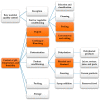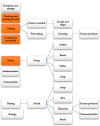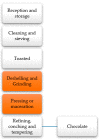The Potential of Selected Agri-Food Loss and Waste to Contribute to a Circular Economy: Applications in the Food, Cosmetic and Pharmaceutical Industries
- PMID: 33478152
- PMCID: PMC7835992
- DOI: 10.3390/molecules26020515
The Potential of Selected Agri-Food Loss and Waste to Contribute to a Circular Economy: Applications in the Food, Cosmetic and Pharmaceutical Industries
Abstract
The food sector includes several large industries such as canned food, pasta, flour, frozen products, and beverages. Those industries transform agricultural raw materials into added-value products. The fruit and vegetable industry is the largest and fastest-growing segment of the world agricultural production market, which commercialize various products such as juices, jams, and dehydrated products, followed by the cereal industry products such as chocolate, beer, and vegetable oils are produced. Similarly, the root and tuber industry produces flours and starches essential for the daily diet due to their high carbohydrate content. However, the processing of these foods generates a large amount of waste several times improperly disposed of in landfills. Due to the increase in the world's population, the indiscriminate use of natural resources generates waste and food supply limitations due to the scarcity of resources, increasing hunger worldwide. The circular economy offers various tools for raising awareness for the recovery of waste, one of the best alternatives to mitigate the excessive consumption of raw materials and reduce waste. The loss and waste of food as a raw material offers bioactive compounds, enzymes, and nutrients that add value to the food cosmetic and pharmaceutical industries. This paper systematically reviewed literature with different food loss and waste by-products as animal feed, cosmetic, and pharmaceutical products that strongly contribute to the paradigm shift to a circular economy. Additionally, this review compiles studies related to the integral recovery of by-products from the processing of fruits, vegetables, tubers, cereals, and legumes from the food industry, with the potential in SARS-CoV-2 disease and bacterial diseases treatment.
Keywords: agri-food waste valorization; antioxidants; bioactive compounds; circular economy; colorants; fruit peel; fruit seeds.
Conflict of interest statement
The authors declare no conflict of interest.
Figures











References
-
- Tomiyama J.-M., Takagi D., Kantar M.B. The effect of acute and chronic food shortage on human population equilibrium in a subsistence setting. Agric. Food Secur. 2020;9:1–2. doi: 10.1186/s40066-020-00261-x. - DOI
-
- World Food Programme Zero Hungry. [(accessed on 17 November 2020)]; Available online: https://www.wfp.org/zero-hunger.
-
- Garza-Reyes J.A., Kumar V., Batista L., Cherrafi A., Rocha-Lona L. From linear to circular manufacturing business models. J. Manuf. Technol. Manag. 2019;30:554–560. doi: 10.1108/JMTM-04-2019-356. - DOI
-
- Subramanian K.R. The Crisis of Consumption of Natural Resources. Int. J. Recent Innov. Acad. Res. 2018;2:8–19.
-
- Castrica M., Rebucci R., Giromini C., Tretola M., Cattaneo D., Baldi A. Total phenolic content and antioxidant capacity of agri-food waste and by-products. Ital. J. Anim. Sci. 2019;18:336–341. doi: 10.1080/1828051X.2018.1529544. - DOI
Publication types
MeSH terms
Substances
LinkOut - more resources
Full Text Sources
Other Literature Sources
Miscellaneous

